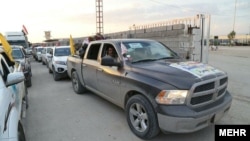Recent floods in Iran have killed dozens and displaced possibly millions of Iranians. Instead of helping them, most of the Islamic Republic’s time and energy has gone into sending foreign Hashd al Shaabi and Hezbollah fighters into Khuzestan.
These forces have engaged in light flood repair for show, but in reality they lack the equipment or skills to do any serious flood relief. Instead, they’re in southwestern Iran because Ayatollah Khamenei fears a revolt. The Hashd and Hezbollah do what they do best: intimidate, harass, and if need be, torture and kill. But their presence in Iran shows a critical weakness for Khamenei as well. And it may prove one of the bigger mistakes he has made.
The floods and the regime’s unwillingness and incompetence have led to widespread anger against the regime in Khuzestan and Lorestan provinces. Many of the Iranians affected are ethnic minorities such as Arabs, Lors, Bakhtiaris, and many others. The Arabs have in particular been a subject of the harshest of discriminations.
Although Khuzestan houses Iran’s oil wealth, Arab Iranians have received very little of it. They are poor and neglected, but still fierce and resilient. Like millions of other Iranians, they have taken to the streets for the past sixteen months in protest against a corrupt and mafia like regime. No wonder the Islamic Republic establishment is afraid. Not only Arab Iranians, but the Lors, are some of the fiercest and most independent peoples that make up the Iranian nation.
Thousands of foreign forces appear to have been allowed into Iran by Khamenei. Many come from some of the most violent regional armed conflicts; both Hezbollah and the Hashd are used by Khamenei to control Lebanon, Syria, and parts of Iraq. Hezbollah has been the vanguard of the Assad regime’s genocidal quest to suppress Syria’s opposition; the Hashd have been responsible for religious cleansing and systematic executions throughout Iraq.
But their presence on Iranian soil shows that Khamenei may not fully trust his own security forces, including the Basij and the Revolutionary Guards. Iranians are less likely to kill their own brothers and sisters while mercenaries like Hezbollah and the Hashd are less caring of Iranians.
The regime has faced the floods at the worst time possible. It is under severe economic pressure and could soon see a near total economic blockade through sanctions. The regime can hardly afford the estimated nearly ten billion dollars in flood damages. And the vast majority of Iranians want Khamenei and his regime gone forever. But they fear an uncertain future if the regime falls.
America should put as much as sanctions pressure on Hezbollah and the Hashd as possible. They’re the enemies and occupiers of the Iranian people. The Hahshd in particular should come under greater sanctions as the U.S. pressures Baghdad to reign in pro-Khamenei groups. Iran may be strong in Iraq, but its influence has weakened in the face of popular Iraqi riots against Khamenei’s regime. The U.S. should also launch an information operation campaign both against Hezbollah in Lebanon and the Hashd in Iraq. Many Lebanese and Iraqis share Iranians’ hatred of Khamenei and his mercenary armies.
As the U.S. puts pressure on the regime’s external mercenaries, a closer look at the regime’s lobbies and influence networks in America, Canada, and Europe are urgently warranted. For too long, many of these groups have engaged in shady activities trying to sway public opinion and manipulate politicians.
The future presence of Khamenei’s mercenaries wouldn’t be a surprise in bigger cities such as Shiraz, Kermanshah, Esfahan, or even in Tehran for that matter. But if there is one thing that angers Iranians, it is the presence of foreign occupiers on their soil. Iran has conquered and been conquered in the last three thousand years, but it has always remained Iranian.
Washington is wise to mimic the cries of Iranians striving to free their nation of forty years of tyranny. An emphasis on America’s opposition to the foreign occupation of Iran would reassure Iranians struggling for a future free of tyranny and abyssal darkness.
More persistent, robust and revealing journalism from foreign based Farsi media including US international broadcasters, regular outreach to the Iranian democratic opposition, and targeting of regime lobbies and former officials in the West are likely to be steps welcomed by Iranians seeking freedom. The message: Iran may be occupied now, but it won’t be occupied forever.








